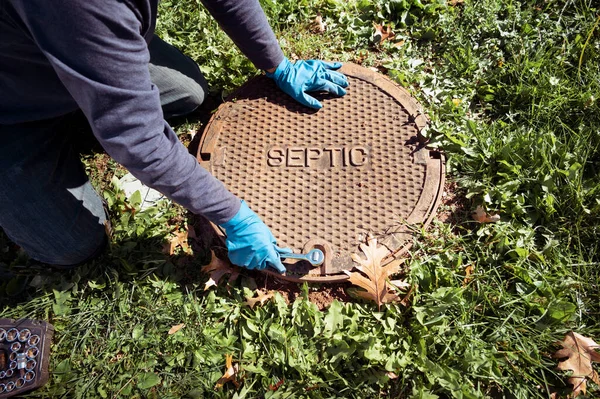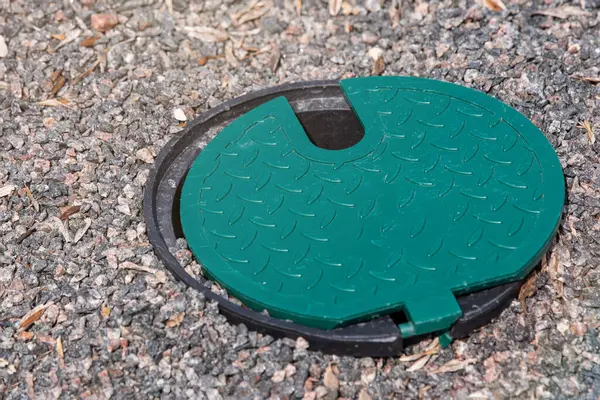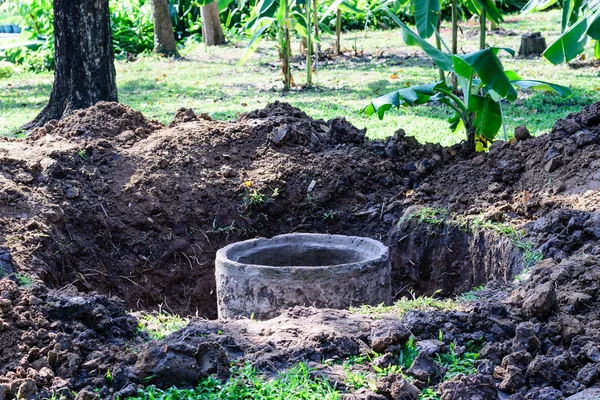In a world increasingly focused on sustainable living and environmental responsibility, understanding the intricacies of septic systems becomes essential.
Whether you are an environmentalist concerned about protecting local water bodies, a homeowner considering an upgrade to your conventional system, or a plumber eager to enhance your expertise, this exploration into septic systems offers valuable insights.
From the importance of proper maintenance to innovative solutions like drip distribution systems and constructed wetland systems, we will cover everything you need to know.
Schedule Service Online
Get a free estimate so you know what you're signing up for
"*" indicates required fields
For Emergency Services Call: 410-255-9300

The Basics of Septic Systems
It consists of a septic tank and a drain field, which work together to treat household wastewater. The septic tank receives wastewater from household plumbing and separates solid materials from liquids.
This initial step is known as primary treatment, where heavy solids settle at the bottom, and lighter substances like oils float to the top.
How Septic Systems Work
A septic system works by allowing wastewater to enter the septic tank, where bacteria break down organic matter. The treated wastewater, or effluent, then flows through a series of perforated pipes into the drain field.
Here, the liquid wastewater percolates through the soil, where the remaining impurities are naturally filtered out.
Properly functioning septic systems are crucial to preventing untreated wastewater from contaminating surface waters or groundwater.
Why Septic Systems Matter
Septic systems play a vital role in environmental protection, reducing the carbon footprint of wastewater treatment by treating it close to the source.
They are especially important in areas where municipal sewer systems are not feasible.
Properly designed and maintained septic systems help protect surface water and groundwater from contamination, ensuring a cleaner, healthier environment for all.

Key Components of a Septic System
Below are the components of a septic system:
The Septic Tank
The septic tank is the heart of any septic system, typically made of concrete, fiberglass, or synthetic materials.
It is responsible for primary treatment, where settled solids accumulate, and liquids pass through to the next stage. Regular septic tank maintenance is crucial to prevent failing septic systems and ensure efficient wastewater treatment.
The Drain Field
Also known as the leach field, the drain field disperses wastewater into the soil, allowing for secondary treatment. The treated wastewater flows through perforated pipes buried in the soil, where it undergoes further treatment.
Soil type and conditions play a significant role in the effectiveness of the drain field, influencing how well wastewater is filtered before it reaches surface water or groundwater.
Distribution System
The distribution box or pump chamber is a key component in distributing effluent evenly across the drain field.
In some systems, a drip distribution system is used to release small amounts of treated wastewater into the soil.
This method minimizes the risk of over-saturating the soil and ensures even distribution, reducing the likelihood of system failure.
Types of Septic Systems
Below are the different types of septic systems commonly seen:
Conventional Septic System
Conventional septic systems are the most common type, consisting of a septic tank and a leach field.
These systems rely on native soil to filter and treat wastewater.
Properly maintained conventional systems can last for decades, providing effective wastewater treatment for rural households.
Aerobic Systems
Aerobic systems introduce air into the septic tank to promote the growth of oxygen-loving bacteria.
These bacteria are more efficient at breaking down organic matter, resulting in cleaner effluent.
Aerobic systems are often used in areas with unsuitable soil conditions for conventional systems or where additional treatment is required.
Chamber Systems
Chamber systems use a series of connected chambers to disperse wastewater, eliminating the need for gravel or stone in the drain field.
This design allows for greater flexibility in site design and can be particularly beneficial in areas with limited space.

Maintaining A Properly Functioning Septic System
Maintaining your septic system consists of inspections, pumping, and responsible
Regular Inspections
Routine inspections by a septic professional are essential to ensure your system is functioning properly.
These inspections can identify potential issues before they become costly problems, such as tree roots infiltrating the system or clogged effluent filters.
Pumping the Septic Tank
Septic tanks should be pumped every three to five years, depending on household size and water usage.
Regular pumping prevents the buildup of solid materials, which can lead to failing systems and costly repairs.
Responsible Water Usage
Conserving water helps reduce the strain on your septic system, extending its lifespan.
Avoid overloading the system by spacing out activities that require large amounts of water, such as laundry and dishwashing.
Advanced Septic System Technologies
The ever-changing technology in sewer and septic systems continues to emerge:
Drip Distribution Systems
Drip distribution systems offer an innovative approach to dispersing treated wastewater. By releasing small amounts of effluent directly into the soil, these systems minimize the risk of soil saturation and provide more consistent treatment.
Constructed Wetland Systems
Constructed wetland systems mimic natural wetlands to treat wastewater. These systems use plants and microorganisms to break down contaminants, offering an environmentally friendly alternative to traditional septic systems.
Sand Filters
Sand filters provide an additional layer of treatment for septic tank effluent. The effluent is filtered through layers of sand, removing suspended solids and remaining impurities before being released into the environment.
Environmental Impact of Septic Systems
Properly designed and maintained septic systems help protect water bodies from pollution.
By treating wastewater close to its source, septic systems reduce the risk of contaminants entering surface waters or groundwater.
Reducing Carbon Footprint
Septic systems have a lower carbon footprint compared to municipal sewer systems, as they require less energy for treatment and transportation. This makes them an environmentally friendly choice for rural areas.
Supporting Sustainable Living
By using natural processes to treat wastewater, septic systems support sustainable living and reduce reliance on chemical treatments. This aligns with the values of environmentalists and DIY enthusiasts seeking eco-friendly solutions.
Common Challenges and Solutions
Failing septic systems can result in untreated wastewater contaminating the environment. Regular maintenance and prompt repairs can prevent failures and ensure your system functions efficiently.
Local Regulations
Understanding local regulations is essential for maintaining compliance and avoiding fines. A septic professional can help ensure your system meets all necessary requirements.
Soil Conditions
Poor soil conditions can impact the effectiveness of a septic system. In such cases, alternative systems like aerobic or constructed wetland systems may be more suitable.

The Role of Septic Professionals
Septic professionals provide valuable expertise and guidance in designing, installing, and maintaining septic systems. Their knowledge ensures your system operates efficiently and complies with local regulations.
MD Sewer And Plumbing offers sump pump services and other sewer services. Contact us today!
Routine Maintenance
Regular maintenance by a septic professional can extend the lifespan of your system and prevent costly repairs. They can identify potential issues and recommend solutions to keep your system running smoothly.
Troubleshooting and Repairs
When problems arise, septic professionals have the skills and experience to troubleshoot and repair your system. Their expertise can save you time and money by addressing issues before they escalate.

The Relationship Between Sewer Systems and Septic Systems
Sewer systems and septic systems are two distinct methods of wastewater management, each serving important roles in sanitation and public health. Municipal sewer systems transport wastewater from homes and businesses to treatment plants, where it undergoes extensive treatment before being released into the environment. In contrast, septic systems treat and dispose of wastewater onsite, primarily in rural areas.
The choice between a sewer and a septic system often depends on the location, population density, and local regulations.
In densely populated urban areas, sewer systems are more practical due to the concentration of wastewater and the infrastructure available to support large-scale treatment facilities.
However, in rural regions, septic systems provide an effective solution without the need for extensive piping or treatment facilities.
Despite their differences, both systems aim to protect public health and the environment by treating wastewater.
It is essential for homeowners and communities to understand the implications of both systems, as well as the regulatory requirements governing their installation and maintenance, ensuring that they contribute to a sustainable and healthy environment.

Septic Systems vs. Municipal Sewer
Below is a comparison of septic tank systems and municipal sewer systems:
Cost Considerations
A septic tank system will be often more cost-effective than connecting to a municipal sewer system, particularly in rural areas.
They eliminate the need for monthly sewer fees and can be more affordable to install and maintain.
Environmental Impact
Septic systems have a lower environmental impact compared to municipal sewer systems, as they treat wastewater close to its source.
This reduces energy consumption and the risk of pollution.
Independence and Flexibility
Septic systems offer greater independence and flexibility, allowing homeowners to choose the best system for their specific needs and preferences.
This can be particularly beneficial in areas with unique soil conditions or limited infrastructure.
Innovations in Wastewater Treatment
Emerging technologies are continually improving the efficiency and effectiveness of wastewater treatment.
From advanced filtration systems to solar-powered pumps, these innovations offer exciting opportunities for the future of septic systems.
Sustainable Solutions
Sustainable solutions, such as constructed wetlands and aerobic systems, are gaining popularity for their eco-friendly approach to wastewater treatment.
These systems align with the values of environmentally conscious homeowners and DIY enthusiasts.
The Future of Septic Systems
The future of septic systems is bright, with ongoing research and development paving the way for more efficient and sustainable solutions. By staying informed and adopting new technologies, homeowners can contribute to a cleaner, healthier environment.

Conclusion
Septic systems play a crucial role in wastewater treatment, offering an eco-friendly and cost-effective solution for rural areas.
By understanding the components, types, and septic system maintenance requirements, homeowners can ensure their systems operate efficiently and protect the environment.
Whether you’re an environmentalist, DIY enthusiast, homeowner, or plumber, staying informed about septic systems can help you make informed decisions and contribute to a cleaner, healthier world. ‘
To learn more or explore further resources, consider consulting a septic professional or researching the latest innovations in wastewater treatment.




